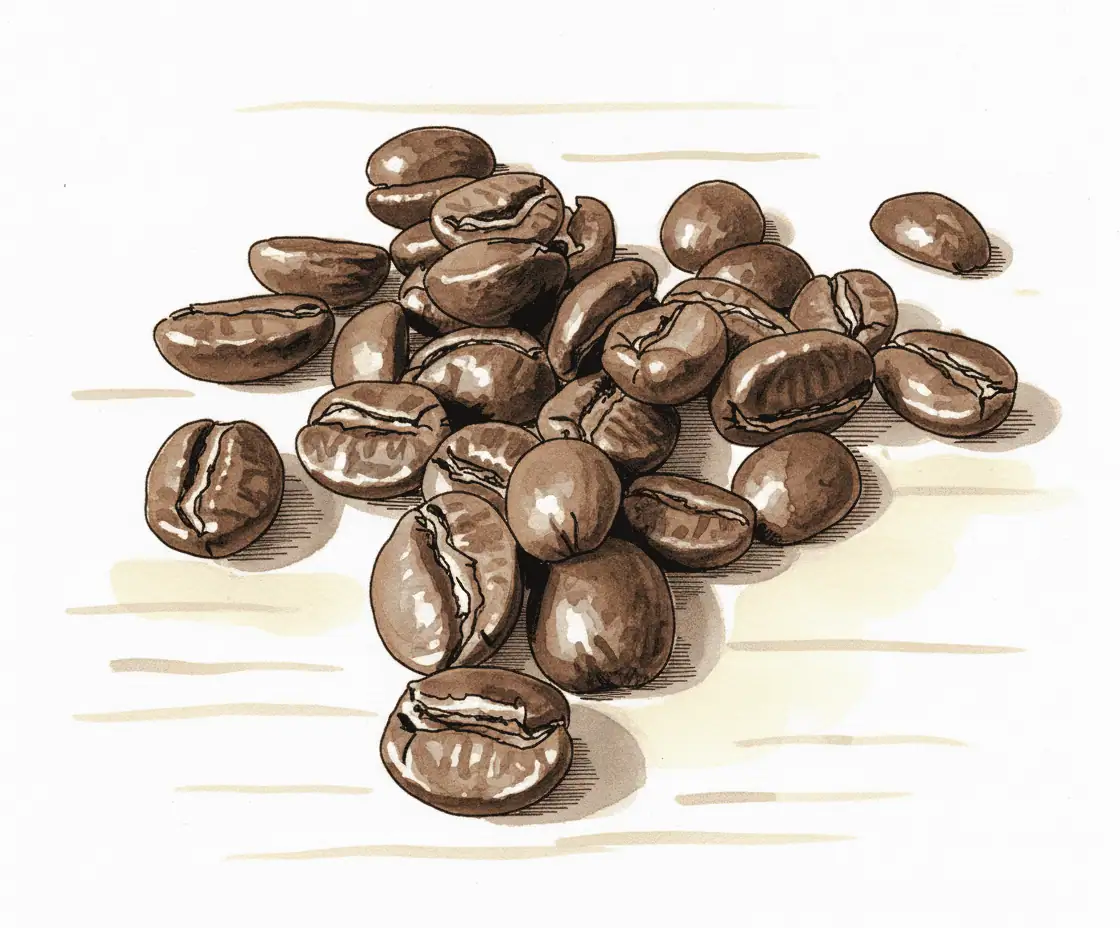High-Altitude Coffee
At high altitudes (above 1500 meters), coffee cherries ripen more slowly, resulting in denser beans with pronounced aromas. The lower temperature and thinner air foster a complex flavor profile, often characterized by high acidity and fruity, floral, or wine-like notes. Regions such as Ethiopia and parts of Latin America are known for their high-altitude coffees, which are prized for their refined and sparkling character.
High‑altitude coffee beans

Colombia
Op Kop Colombia is een medium roast met een helder, fruitig profiel. De bonen komen uit regio’s als Huila, Antioquia en Tolima en worden gewassen verwerkt voor een zuivere, frisse smaak. Verwacht tonen van amandel, kers, chocolade en karamel, ondersteund door een medium body en milde zuurgraad. Geschikt voor espresso, filter, French press en percolator,…

Colombia
Deze koffie uit Colombia komt uit Huila en wordt als single origin gebrand door Borgman en Borgman. De bonen groeien rond 1800 meter en ondergaan een gewassen proces, wat zorgt voor heldere smaken en een fijne body. Verwachte tonen zijn rozijn, chocolade en fruit, passend bij het terroir van Huila. De branding gebeurt vers in…

Colombia
Colombiaanse koffie uit Cauca komt van het Papayan plateau met vulkanische bodem en schaduwbomen. Het gaat om 100 procent Arabica met variëteiten Excelso en Supremo. De branding is richting medium wat zorgt voor een zachte body met frisse zurigheid, rijpe fruittonen, kers en noot. Handmatig geplukt, 12 uur gefermenteerd en zongedroogd voor consistente kwaliteit. Geschikt…

Colombia
Deze Colombia van Koffiebranderij Venetië richt zich op balans en drinkplezier. Verwacht een helder profiel met medium zuurgraad en een fruitig aroma. De boon past in het klassieke Colombiase spectrum, met ruimte voor chocolade en noot. Gewassen verwerking ligt voor de hand en versterkt de definitie in de kop. Dankzij de hoogte rijpen bessen traag,…

Colombia
Deze microlot uit Acevedo in Huila laat Pink Bourbon schitteren. Refill en Rebl Coffee roosteren kleinschalig; het gewassen proces levert een schone kop met nuance en zoetheid.Proefnotities zwarte kers, bloedsinaasappel, cacaoTextuur zijdeachtig, zuren sappig en helderSCA score 87,5 kwaliteit bevestigdFlorale hints openen de neus, de afdronk blijft fruitgedreven en lang aanwezig.

Colombia
Deze Colombia uit Huila draait om helderheid en balans, dankzij het gewassen proces en zorgvuldige branding. Verwacht melkchocolade, frisse appel en een ronde body met een schone afdronk. De hoogte van 1300 tot 1900 meter geeft een strakke structuur en levendige zuren.Profiel blijft netjes bij langere of kortere extractie.Geschikt voor filter en milde espresso, geen…

Colombia
Roast’n Toast presenteert “Colombia”, een single origin die de klassieke Andesstijl laat spreken. Hoogte en vulkanische bodems brengen zoetheid en gelaagde zuren. De boon is washed verwerkt, wat zorgt voor een schone, heldere kop met rond mondgevoel en prettige balans.Smaak: melkchocolade, bruine suiker, rode appel, zachte aardsheid.Gebruik: ideaal als espresso, sterk in cappuccino en flat…

Colombia
Deze single origin uit Timaná in Huila toont waarom Colombia zo geliefd is. The Coffee Lodge kiest voor fully washed verwerking, wat zorgt voor een schone, precieze kop. Verwacht een volle body met cranberryfrisheid, karamelzoetheid en donkere cacao in de afdronk. De branding is medium tot dark en blijft gericht op balans en duidelijke smaken.Herkomst…

colombia – acevedo
Colombia Acevedo uit Huila staat bekend om schone, evenwichtige koffie van 2000 meter hoogte. White Label Coffee biedt een gewassen oogst 2024 met variëteiten Castillo, Caturra en Colombia. Het brandprofiel neigt naar medium, met tonen van karamel, zwarte thee en nougat, waardoor zoetheid en nuance in balans blijven. Filtermethoden zoals V60 en Chemex benadrukken helderheid,…

Colombia – Decaf
Colombia Decaf van Independent Coffee Roasters levert een zachte, zoete kop die direct vertrouwen wekt. De boon komt uit hoger gelegen regio’s in Colombia en is gede-cafeïneerd met de sugarcane EA methode voor maximale aromabehoud. Verwacht chocolade, karamel en bruine suiker, met schone aciditeit en een romige body. Dankzij het omni roast profiel presteert deze…

Colombia – DECAF – Sugarcane
Colombia Decaf Sugarcane komt uit Argelia op circa 1800 meter. De blend van Castillo, Caturra, Catimor en Typica wordt lokaal gedecafeïneerd met natuurlijk EA uit suikerriet in Palmira. Het resultaat is een volle espresso met tonen van bruine suiker, zwarte bes en een romig mondgevoel. Er wordt wekelijks op bestelling gebrand, verzending op donderdag en…

Colombia – Finca el Mirador
Independent Coffee Roasters presenteert Colombia Finca el Mirador uit Acevedo, Huila. Deze gewassen Tabi geeft helder rood fruit, met aardbei, rode bes en een cacaoachtige finale. De body is medium en zijdeachtig, de zuren zijn rijp en wijnachtig. De lichte tot medium branding bewaart zoetheid en precisie.Filter, V60 of Kalita benadrukt precisie en fruit.Espresso, kies…

Colombia – Fruit Juice
Fruit Juice van Five Ways is een Sidra microlot uit Pitalito Huila. De lichte filterbranding bewaart florale aroma’s en laat heldere, zoete zuren mooi spreken. De natuurlijke anaerobe verwerking bouwt lagen op van roos, Turkish delight en tropisch fruit.Proces, 48 uur oxidatie, thermische schok, anaerobe fermentatie, daarna langzaam zondroog.Smaak, milky oolong mondgevoel, rozengeur, ananas en…

Colombia, Jardines del Encanto, Maragesha Competition lot
This filter roast comes from the Jardines del Encanto finca in Huila at 2050 meters. The rare Maragesha, a cross between Gesha and Maragogype, was discovered in Colombia in 2017 and scores above 90 points. Cofinet applies the EF2 natural process with careful handpicking and slow drying, which preserves clarity and complex fruitiness…
High Altitude (above 1500 meters)
Welcome to the world of high-altitude coffee! When you think of beans grown above 1500 meters, words like “refined,” “complex,” and “vibrant” often come to mind. But why exactly? In this article, we’ll dive into the effects of high altitudes on your espresso, the chemical composition of the beans, processing methods, and much more.
How altitude affects espresso flavor
At high altitudes, coffee cherries mature more slowly. This gradual ripening process allows sugars and acids in the fruit to develop over time, giving the beans ample opportunity to build a full range of flavors. When you use these beans for espresso, you’ll often taste a refined acidity and floral or fruity characteristics—think subtle citrus or berry aromas with a bright, almost “sparkling” quality. If you enjoy a delicate espresso, high-altitude beans are an excellent choice.
Chemical composition: density, sugars, and acids
Because the air is thinner and cooler at higher elevations, coffee trees receive less oxygen and grow at a slower pace. This results in denser beans that often exhibit higher acidity. The sugars develop more gradually, and the extended ripening contributes to a complex flavor structure. You end up with a bean that balances sweetness and complexity, translating into a lively cup of coffee. The increased density also impacts roasting profiles: roasters usually take extra care to highlight all those nuanced flavors.
Processing methods at high altitude
Thanks to the cooler, sometimes more humid climate, some coffee farmers opt for processing techniques that emphasize their beans’ unique characteristics. In many high-altitude regions, the washed method is especially popular, as it accentuates fruity and floral notes. Removing the pulp and mucilage under carefully controlled conditions allows any impurities to wash away, leaving a clean, pure flavor. There’s also some experimentation with natural and honey processes in these regions, though washed processing is often the standard for maintaining clarity.
Climate and microclimate
High-altitude environments have unique weather conditions: cooler nights, milder days, and often more rainfall. In some places, mist clings to the mountainsides, creating microclimates that can vary even from one slope to the next. This contributes to the slow ripening of cherries and the development of complex aromas. On the flip side, coffee farmers face challenges like fungal diseases in damp conditions, but the reward is a flavor profile cherished worldwide.
Yield and resilience
Growing coffee at 1500 meters or higher isn’t easy. The trees often produce fewer cherries because the plants expend more energy just to survive in cooler temperatures. Still, the beans command a premium for their pronounced quality and distinctive taste. Many farmers form cooperatives to share knowledge about cultivating coffee under these challenging conditions, employing innovative irrigation methods or using shade trees to protect their coffee plants.
Choosing coffee varieties
Not all coffee plants thrive at 2000 meters. Farmers often select varieties that can handle the cold and resist diseases, such as certain Arabica strains (like Bourbon, Typica, or Geisha). These varieties are known for their potential to develop subtle flavor nuances—a perfect match for the special circumstances high altitudes provide.
All in all, coffee from high altitudes isn’t just any cup of joe. Expect floral notes, a lively acidity, and refined aromas that will delight anyone seeking a bright and complex coffee experience.
